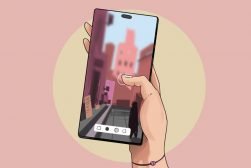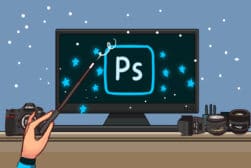How to Depixelate an Image (+ How to Avoid Pixelated Pictures)
Master the techniques to depixelate images and learn how to avoid pixelation in future shots, ensuring clear and high-quality photographs.
Learn | By Andrew Dilks
This is a guide exploring how to depixelate an image using a variety of free and paid tools.
Whether you’ve downloaded images in low resolution or shot using high ISO, image pixelation can be an issue.
To help with the problem, I’ve broken down how you can avoid generating pixelated images and what you can do to fix them.
I’ll cover the best programs and online tools for the task, as well as the relevant tools you’ll need to use.
What Is a Pixelated Image?
A pixelated image features individual blocks of color with a clear point where each block meets.
The image is divided into these individual blocks in the form of a graphic, with the square pixels visible to the naked eye.
It can be found in photography and videography and can be caused by a variety of factors, from hardware to image size.
There are some situations where a pixelated effect is desirable, for example, when censoring a portion of the image to hide nudity.
Video games have also used pixel art to great effect, with many indie developers still using this style of art for retro aesthetics.
In photography, however, pixelation is largely an undesirable effect along the lines of blurry photos and needs to be addressed.
What Causes Pixelation (and How to Avoid It)
If you have a pixelated picture, there are several reasons why this might be the case, depending on the image’s source.
Low-resolution images, typically used on the internet, will pixelate when enlarged and result in a blocky and ill-defined appearance.
This occurs when the image is stretched beyond its optimal resolution, reducing the smoothness of the edges and crisp colors.
Certain camera settings can also result in pixelation, particularly when shooting in low light conditions using a high ISO setting.
As the sensor opens up due to the high ISO setting, additional noise is introduced along with the additional light.
Highly compressed image files are also prone to artifacts such as pixelation when reduced to very low file sizes.
How to Depixelate an Image in Photoshop
With many photographers already invested in Adobe’s photography subscription package, Photoshop is the go-to software for depixelating images.
Adobe Photoshop has several handy tools and processes for the task, so you can try each of these in isolation or combined to get the best results.
Here’s how you can improve your pixelated images using Photoshop’s various features:
Using the Smart Blur and Despeckle tools
One of the best ways to quickly address pixelation in Photoshop is by using the software’s blur tools and adding a gentle Gaussian blur to the image.
How Much Do You REALLY Know About Photography?! 🤔
Test your photography knowledge with this quick quiz!
See how much you really know about photography...

This will soften the image and reduce the blockiness inherent in pixelation, with the radius control allowing you to define how much it is applied to pixels.
Additionally, you can use the program’s Despeckle tool to address the issue, which can be found in the Noise filter category.
Apply the Sharpen tool in the Camera RAW settings
Photoshop includes a powerful sharpening tool that is often used to improve a blurry photo but also works well for pixelated images.
This tool is grouped with the Blur tool and can be used in conjunction with brushes for specific applications to areas of the image.
You can also access this tool in the Camera RAW program, addressing the image’s issues at the highest possible quality and resolution.
Resampling with the Bicubic Smoother tool
One of the more unique tools used by photographers to create a depixelated image is resampling, which is assisted by powerful AI processing.
This is particularly relevant when increasing the resolution of a smaller image that might otherwise be affected by pixelation during the process.
When resizing the image, check the Resample Image option at the bottom of the window then select Bicubic Automatic from the drop-down list.
You can also use the Reduce Noise tool to refine the results and create a smooth and sharp image free from pixelation.
How to Depixelate an Image in GIMP
If you don’t have a license for Adobe Photoshop, GIMP is a popular and free alternative you can use to quickly unpixelate images.
While not as comprehensive as Photoshop, it’s a great platform to fix pixelated photos in just a few clicks.
Simply load up your pixelated photos into GIMP and follow these image processing steps:
Use the Blur Filter
With your image opened in the software, use the relevant select tool, if appropriate, to highlight the area of the image that is pixelated.
Next, head to the Toolbox and choose the Gaussian Blur filter ready to apply to the selected area.
Adjust the filter’s settings until the pixelated area of your image is smoothed out, using the horizontal and vertical radius controls.
Reduce pixelation with the Despeckle filter
If you’re unhappy with the results gained from the blur tool, you can also apply the despeckle filter in GIMP.
As with Photoshop, the median controls covering Adaptive and Recursive settings will help you to achieve the levels you desire.
Once you’re happy with the level of depixelation from these adjustments, you can apply them across the image or click OK to confirm the selected area.
How to Depixelate an Image Online
Photographers who don’t have the time to address pixelated images through dedicated software can fix these images online for free.
Several websites allow users to upload low-resolution images and other pixelated pictures to improve image quality without any fees.
Here are a couple of online tools that are highly recommended by photographers and graphic designers.
How to Depixelate an Image Online for Free
FOTOR is known for its impressive photo editing app, which I’ve covered below, but also has on-site tools to fix pixelated images.
To use the service and fix your images online for free, simply upload the relevant image file to the website to access the editing tools.
You can then adjust the image’s blur settings and intensity, using the circular and linear options to tailor the results.
Additional edits using the structure tool can also be used to bring more detail back into the image and minimize the pixelation.
Let’s Enhance also includes tools to help you depixelate images online for free, using AI to improve the end results.
The website uses a Smart Enhance mode to fix issues caused by compression and other problems caused by upscaling images.
Lastly, if you need to address multiple photos, you can use Claid.AI to batch-process and unpixelate images in bulk quantities.
The Best Apps for Depixelating Images
Street photographers and others who perform their post-processing editing work on the go don’t always have the means to access a laptop.
Fortunately, many excellent photo editing apps include the necessary tools that can be used to fix a pixelated image on a smartphone.
If you’re invested in the Adobe ecosystem and have the Lightroom app version, you can use this to address pixelation with the Sharpen tool.
This can be combined with the masking slider to apply the sharpening effect to specific areas of the image for a more fine-tuned approach.
FOTOR is another great photography app that features tools for depixelating images by combining sharpening with the Structure feature.
Additional mobile apps that include the necessary photo editing tools for the task include PIXLR and Enhance Photo Quality, available for both Android and iOS.
FAQs on Pixelated Images
Is AI the best way to depixelate an image?
Artificial intelligence tools for the post-processing of photographs are evolving at a rapid pace and can help fix pixelated images in your library.
With that said, professional photographers who understand how to maximize tools in programs such as Adobe Photoshop are likely to get better results.
But as a quick and easy-to-use solution, AI can help enhance a pixelated picture or batch process multiple images with ease.
It’s possible to reverse the pixelation of a censored photo by using some of the tools outlined above such as the sharpener tool.
While these tools will help you fix pixelated image files that have been censored, it won’t bring it back to their original image.
What are the best tools to depixelate images?
Various image processing software have a range of tools to use when fixing a pixelated image, from sharpening tools to adding blur.
Some have bespoke depixelation tools that can be applied to images, while others can resample and enhance images.
There are also tools to unpixelate images online, such as VanceAI PC and YouCam AI Photo Enhancer, which use AI to handle the process.
How do I depixelate an image in Pixlr?
If you’re using Pixlr, you can use the sharpen tool to address the problem by adjusting the intensity of the sharpening effect.
You can find this setting in the Adjustments menu in the top toolbar’s drop-down menu, with Sharpen listed in this menu.

Check out these 8 essential tools to help you succeed as a professional photographer.
Includes limited-time discounts.











